Lewis(x) and alpha2,3-sialyl glycans and their receptors TAG-1, Contactin, and L1 mediate CD24-dependent neurite outgrowth
- PMID: 19458237
- PMCID: PMC6665889
- DOI: 10.1523/JNEUROSCI.4361-08.2009
Lewis(x) and alpha2,3-sialyl glycans and their receptors TAG-1, Contactin, and L1 mediate CD24-dependent neurite outgrowth
Abstract
Although carbohydrates have been implicated in cell interactions in the nervous system, the molecular bases of their functions have remained largely obscure. Here, we show that promotion or inhibition of neurite outgrowth of cerebellar or dorsal root ganglion neurons, respectively, induced by the mucin-type adhesion molecule CD24 depends on alpha2,3-linked sialic acid and Lewis(x) present on glia-specific CD24 glycoforms. Alpha2,3-sialyl residues of CD24 bind to a structural motif in the first fibronectin type III domain of the adhesion molecule L1. Following the observation that the adhesion molecules TAG-1 and Contactin show sequence homologies with fucose-specific lectins, we obtained evidence that TAG-1 and Contactin mediate Lewis(x)-dependent CD24-induced effects on neurite outgrowth. Thus, L1, TAG-1, and Contactin function as lectin-like neuronal receptors. Their cis interactions with neighboring adhesion molecules, e.g., Caspr1 and Caspr2, and with their triggered signal transduction pathways elicit cell type-specific promotion or inhibition of neurite outgrowth induced by glial CD24 in a glycan-dependent trans interaction.
Figures
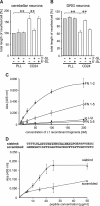

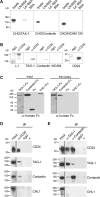
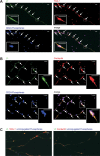
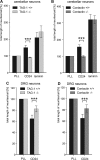
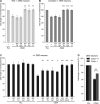
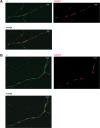




Similar articles
-
Cellular form of prion protein inhibits Reelin-mediated shedding of Caspr from the neuronal cell surface to potentiate Caspr-mediated inhibition of neurite outgrowth.J Neurosci. 2010 Jul 7;30(27):9292-305. doi: 10.1523/JNEUROSCI.5657-09.2010. J Neurosci. 2010. PMID: 20610764 Free PMC article.
-
The neural recognition molecule L1 is a sialic acid-binding lectin for CD24, which induces promotion and inhibition of neurite outgrowth.J Biol Chem. 2001 Jun 15;276(24):21656-63. doi: 10.1074/jbc.M101790200. Epub 2001 Mar 30. J Biol Chem. 2001. PMID: 11283023
-
Several extracellular domains of the neural cell adhesion molecule L1 are involved in neurite outgrowth and cell body adhesion.J Neurosci. 1993 Nov;13(11):4764-75. doi: 10.1523/JNEUROSCI.13-11-04764.1993. J Neurosci. 1993. PMID: 8229197 Free PMC article.
-
Tenascin-contactin/F11 interactions: a clue for a developmental role?Perspect Dev Neurobiol. 1994;2(1):43-52. Perspect Dev Neurobiol. 1994. PMID: 7530143 Review.
-
F3/contactin, a neuronal cell adhesion molecule implicated in axogenesis and myelination.Biol Cell. 2002 Oct;94(6):327-34. doi: 10.1016/s0248-4900(02)00006-0. Biol Cell. 2002. PMID: 12500940 Review.
Cited by
-
Cryo-EM structures of the full-length human contactin-2.FEBS J. 2025 Feb;292(3):602-618. doi: 10.1111/febs.17364. Epub 2024 Dec 19. FEBS J. 2025. PMID: 39702996 Free PMC article.
-
CD24 as a Potential Therapeutic Target in Patients with B-Cell Leukemia and Lymphoma: Current Insights.Onco Targets Ther. 2022 Nov 18;15:1391-1402. doi: 10.2147/OTT.S366625. eCollection 2022. Onco Targets Ther. 2022. PMID: 36425299 Free PMC article. Review.
-
Myelin basic protein cleaves cell adhesion molecule L1 and promotes neuritogenesis and cell survival.J Biol Chem. 2014 May 9;289(19):13503-18. doi: 10.1074/jbc.M113.530238. Epub 2014 Mar 26. J Biol Chem. 2014. PMID: 24671420 Free PMC article.
-
Structurally distinct LewisX glycans distinguish subpopulations of neural stem/progenitor cells.J Biol Chem. 2011 May 6;286(18):16321-31. doi: 10.1074/jbc.M110.201095. Epub 2011 Mar 8. J Biol Chem. 2011. PMID: 21385876 Free PMC article.
-
Functional Diversity of Neuronal Cell Adhesion and Recognition Molecule L1CAM through Proteolytic Cleavage.Cells. 2022 Sep 30;11(19):3085. doi: 10.3390/cells11193085. Cells. 2022. PMID: 36231047 Free PMC article. Review.
References
-
- Basso DM, Fisher LC, Anderson AJ, Jakeman LB, McTigue DM, Popovich PG. Basso Mouse Scale for locomotion detects differences in recovery after spinal cord injury in five common mouse strains. J Neurotrauma. 2006;23:635–659. - PubMed
-
- Berglund EO, Murai KK, Fredette B, Sekerková G, Marturano B, Weber L, Mugnaini E, Ranscht B. Ataxia and abnormal cerebellar microorganization in mice with ablated Contactin gene expression. Neuron. 1999;24:739–750. - PubMed
-
- Bhat MA, Rios JC, Lu Y, Garcia-Fresco GP, Ching W, St Martin M, Li J, Einheber S, Chesler M, Rosenbluth J, Salzer JL, Bellen HJ. Axon-glia interactions and the domain organization of myelinated axons requires neurexin IV/Caspr/Paranodin. Neuron. 2001;30:369–383. - PubMed
Publication types
MeSH terms
Substances
LinkOut - more resources
Full Text Sources
Molecular Biology Databases
